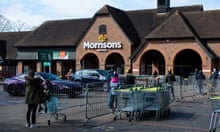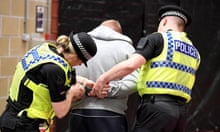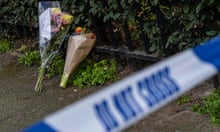Homicides are at a record high for the past decade, knife crime is rising and the proportion of offenders being charged has reached a record low, two sets of official figures show.
The Office for National Statistics said that in the year to December 2018, 732 lives were lost to homicide, compared with 690 the previous year. The figure is the highest number recorded since 2008. Homicide includes murder, manslaughter, corporate manslaughter and infanticide.
The total covers both England and Wales, although in Wales homicides fell from 35 in 2017 to 27 in 2018.
Offences involving knives rose 6%, with police recording 40,829, the highest number the ONS has on record since 2011.
One-third of knife offences were in London and use of bladed weapons was concentrated in urban areas, the ONS said, but there were some signs the increase was slowing.
The ONS said all 43 forces had seen increases in violent offences, including an 11% rise in reported rapes, 46% in stalking, 11% for robbery, 12% in fraud and 8% for theft.
The ONS said the picture was mixed, with no significant change in overall crime and some apparent falls in certain offences.
Firearms offences fell 2% to 6,525 recorded incidents, burglary declined by 3% to 424,846 offences, and computer misuse dropped 28% to 976,000 offences, with fewer devices being infected by viruses, the ONS said.
Overall, crime year on year rose 2%, which the ONS said was not statistically significant.
In its commentary, the ONS said people in England and Wales were now less likely to experience any type of crime than in the mid-1990s. “The likelihood of being a victim of crime has fallen considerably over the long term,” it said.
“Around 40 in 100 adults were estimated to have been a victim of crime in 1995. This was before the survey included fraud and computer misuse in its coverage. Based on crimes comparable with those measured in the 1995 survey, 15 in 100 adults were victims of crime in the year ending December 2018,” the ONS added.
Alexa Bradley from the ONS centre for crime and justice said: “When we look at the overall level of crime, there has been no significant change over the last year.
“However, it is important to look at each crime type separately because the picture is very mixed. Even within crime types we have seen differences. Robbery and vehicle offences have increased, whereas burglary has decreased.
“Lower-volume, high-harm violence involving knives has risen, whereas offences involving firearms have decreased.”
Crime has become a politically charged issue, with Labour and many in the police blaming government cuts for crime increasing as officer numbers have fallen. The complex figures and the morass of crime data allow different conclusions to be drawn, but what does emerge are rises in the most serious offences, some of which are at record levels.
The policing minister, Nick Hurd, said: “Today’s statistics show that your chance of being a victim of crime remains low.
“Yet too many people are still falling victim to serious violence, which is why we will continue our urgent and unprecedented action to reverse this terrible trend.
“We have given police forces additional powers and have this year put more than £1bn extra into policing, including council tax, and £100m specifically for those areas worst affected by violent crime.”
Separate Home Office figures show the proportion of crimes leading to charges or summons falling to 8.2% of the total volume of crimes. It is the joint lowest figure since recording began of those figures in 2002-3.
In more than 1m incidents, victims did not support action – 22% of offences in the year to December 2018.
For rape, just 1.7% of reported offences led to someone being charged or summonsed, and the figure compared to attacks is likely to be worse because academics and police believe only a fraction of offences are reported. In 40% of cases, rape victims did not support further action.
Ché Donald of the Police Federation of England and Wales, which was accused of shroud-waving by the government when it warned that cuts would lead to rising violence, said: “Despite the best efforts of our members, we have seen crime continue to increase, and the resultant demands placed on policing are unprecedented but unfortunately predictable.
“Crime across the board is going up. The only things that are not going up are police numbers, police pay and meaningful funding. The government should be investing in our police service so we can get on with tackling this highly concerning situation. These figures must shame them into action.”
The Labour MP Yvette Cooper, who chairs the home affairs select committee, said: “Knife crime is now at record levels and this is a very disturbing increase in violent crime at the same time as the number of arrests is continuing to fall.
“The police are completely overstretched and crime prevention work is far too limited.
“The Home Office and government response on knife crime and other rising crimes is still far too weak and just doesn’t match the scale of the problem.”









